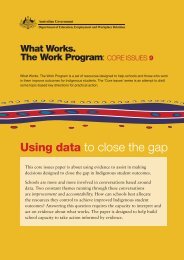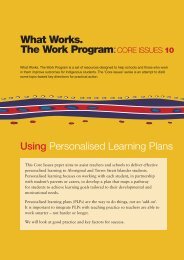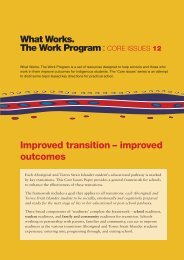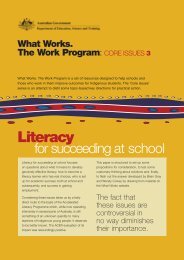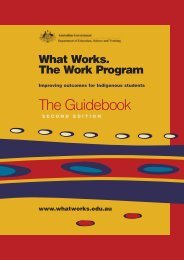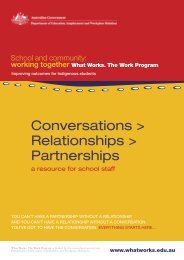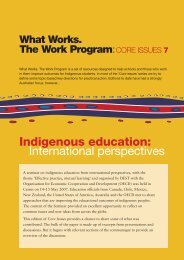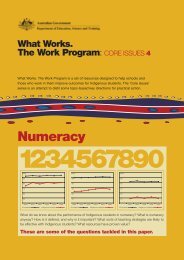Bound for Success Scope and Sequence Statements
Bound for Success Scope and Sequence Statements
Bound for Success Scope and Sequence Statements
- No tags were found...
Create successful ePaper yourself
Turn your PDF publications into a flip-book with our unique Google optimized e-Paper software.
SCIENCENatural <strong>and</strong> Processed MaterialsConcept In Year 1the student:In Year 2the student:In Year 3the student:In Year 4the student:In Year 5the student:In Year 6the student:In Year 7the student:In Year 8the student:In Year 9the student:Properties ofmaterialsDifferent materialshave differentproperties <strong>and</strong> there isa relationship betweentheir properties <strong>and</strong>what they are used <strong>for</strong>• Recognises that things aremade of different materialssuch as wood, plastic,glass, metal, concrete,fabric <strong>and</strong> can say whatcommon things are madeof. T• Uses their senses todescribe the ways thingsfeel different (rough,smooth, hard, soft) lookdifferent (shiny, differentcolours) taste different(sweet, bitter, sour), smelldifferent (nice, nasty).• Says what commonmaterials are used <strong>for</strong> (e.g.says “glass is used <strong>for</strong>windows, bricks are used<strong>for</strong> houses <strong>and</strong> wool isused <strong>for</strong> jumpers”). T• Knows that differentmaterials can also ‘act’ orbehave differently (e.g.elastic b<strong>and</strong>s stretch,aluminium foil scrunches,paper <strong>and</strong> wood dent,fabric <strong>and</strong> paper tear).• Knows that the types ofmaterials things are madefrom <strong>and</strong> what they areused <strong>for</strong> are related (e.g.says “sponges soak upwater” <strong>and</strong> “concrete isused to make footpathsbecause paths are made ofhard stuff”).• Recognises that someobjects look similar but aremade of different materials(e.g. says “this chairs lookthe same but that one ismade of metal <strong>and</strong> this oneis made of plastic”).• Recognises that an objectcan be made from a rangeof different materials (e.g.says “my bike has someparts that are plastic <strong>and</strong>some parts that aremetal”).• Examines <strong>and</strong> comparesthe observable propertiesof common materials in avariety of everyday objects(e.g. says “fur, wool <strong>and</strong>hair are soft <strong>and</strong> concrete,wood <strong>and</strong> metal arehard”).• Recognises that somematerials come fromthings in nature (e.g.wood, wool, milk) <strong>and</strong>some from other sources(e.g. glass).• Underst<strong>and</strong>s that air is atype of material (e.g. says“I can breathe in air” or“when I blow up a balloonit fills up with air” [*air isnot a real substance].• Recognises that a varietyof different objects can bemade from the samematerials (e.g. a bike,knife, jug <strong>and</strong> window -metal; footpath, buildingfence -concrete; cake <strong>and</strong>custard - egg, flour, sugar<strong>and</strong> milk).• Recognises that somematerials are used to makecertain types of things <strong>and</strong>not others (e.g. says “youuse wood <strong>and</strong> concrete tobuild things but can’t makea pillow from concrete”).T• Compares properties of anobject with those of thematerial from which it ismade (e.g. compares eggs<strong>and</strong> sugar (hard <strong>and</strong> runny)with meringue (soft <strong>and</strong>light) <strong>and</strong> s<strong>and</strong>, cement<strong>and</strong> water (hard, powdery<strong>and</strong> runny).• Recognises that differentmaterials are used <strong>for</strong>different purposes <strong>and</strong> hasan underst<strong>and</strong>ing of thereasons in terms ofproperties (e.g. says “thebathroom has tiles on thefloor because it can getwet” <strong>and</strong> “ you can’t use aplastic spoon to take thelid of the tin because it willbreak).• Underst<strong>and</strong>s how theselection of materials <strong>for</strong> aspecific purpose dependson what it is required <strong>for</strong>as well as the properties ofthe materials that are beginconsidered (e.g. a bridgerequires hard, strong, longwearingmaterials ratherthan soft, weak materialssuch as plastic, fabric <strong>and</strong>ceramic).• Chooses materials theyconsider would be best <strong>for</strong>specific purposes based onthe properties <strong>and</strong> sayswhy (e.g. says “I woulduse wood to make a boatbecause it floats”). T• Recognises that there canbe different types of onematerial <strong>and</strong> they havedifferent uses dependingon their properties (e.g.says “paper can be hard orsoft heavy or light, thick orthin <strong>and</strong> that ‘tissue isused <strong>for</strong> blowing noses on<strong>and</strong> thick paper is <strong>for</strong>writing on”).• Knows that all glues stickthings together but thatdifferent glues are used <strong>for</strong>different purposes, <strong>and</strong>different types of stickytape are stronger, wider,<strong>and</strong> more transparent <strong>and</strong>these determine their use.• Knows there are differenttypes of familiar metals<strong>and</strong> can identify somecommon uses <strong>for</strong> these,making connectionsbetween uses <strong>and</strong> theirproperties (e.g. says “gold<strong>and</strong> silver are used <strong>for</strong>making jewellery becausethey shine up well are soft<strong>and</strong> easy to shape” <strong>and</strong>“copper <strong>and</strong> aluminiumare used <strong>for</strong> saucepansbecause they heat upquickly”).• Knows that manymaterials are composed ofparts (e.g. grains or fibres)some of which may not bevisible with the naked eyebut may be visible with amagnifying glass.• Explores the relationshipsbetween properties,composition <strong>and</strong> use ofdifferent materials.• Knows that different typesof one material havedifferent uses but that theyoften share similarproperties because theyhave the same buildingblocks (e.g. says “there arehard plastics such asmelamine, <strong>and</strong> soft plasticssuch as book covering <strong>and</strong>you shouldn’t put softplastics near constantheat” <strong>and</strong> “some ceramicscan go in the oven butsome will break”).• Knows that whether asubstance dissolvesdepends on the quantity<strong>and</strong> type of substance (e.g.says “it’s easy to dissolvea teaspoon of sugar in acup of water but a lotharder to dissolve a half acup of sugar in it” <strong>and</strong>“jelly crystals dissolve bestin boiling water”).• Recognises by using amagnifying glass ormicroscope, that materialsare made up of muchsmaller parts than they firstappear.• Knows the basicdifferences between solids,liquids <strong>and</strong> gases (shape,volume, compressibility,ability to be poured) <strong>and</strong>examples of these.• Knows that matter iscomposed of atoms whichare so small they cannot beseen <strong>and</strong> that an element isa substance made up ofonly one type of atomrecognising that theseoccur as solids, liquids orgases.• Knows that there are over100 types of atoms <strong>and</strong>recognizes fifteen of themost common atoms.• Knows that compounds aremade up of two or moretypes of atoms.• Knows the basic properties(phase, colour, occurrence,use) <strong>and</strong> symbols of thecommon elements.• Produces <strong>and</strong> testshydrogen, oxygen <strong>and</strong>carbon dioxide.• Knows that molecules aremade up of groups ofatoms in prescribednumbers; explains thisusing models <strong>and</strong> writesthe <strong>for</strong>mulae of commonsubstances <strong>and</strong> compoundsincluding water, oxygen,gas, salt, carbon dioxide<strong>and</strong> sugar.• Uses scientific models <strong>and</strong>terms to explain theproperties of materials.• Knows the basic structureof the periodic table <strong>and</strong>recognizes that elementsare grouped togetheraccording to theirproperties.• Compares the properties ofmetals <strong>and</strong> non-metals <strong>and</strong>underst<strong>and</strong>s how these canbe changed by mixing withother substances toproduce alloys; recognisescommon alloys <strong>and</strong> theiruses.• Knows that families ofelements <strong>and</strong> compoundscan have similar structures,properties <strong>and</strong> uses.Recognises symbols of atleast the first twentyelements <strong>and</strong> underst<strong>and</strong>s<strong>and</strong> write the <strong>for</strong>mulae ofcommon compounds.• Knows that atoms have anucleus made up ofprotons <strong>and</strong> neutrons <strong>and</strong> acloud of electrons, <strong>and</strong> theelectric charge of these.• Knows the behaviour ofsolids, liquids <strong>and</strong> gases interms of the particle model<strong>and</strong> describes theproperties of everydaymaterials in terms of themodel including strength,conductivity, hardness,flexibility <strong>and</strong> solubility.• Groups materials based onsimple criteria (e.g.runny/not/runny, hard/soft,strong/weak• Groups or sorts materialsthat are ‘runny’ <strong>and</strong> ‘notrunny’ <strong>and</strong> says which aremore runny than others, orthose that can be poured ornot poured.• Sorts similar materials intogroups based on whatmaterials are used <strong>for</strong> (e.g.groups as building,sewing, cookingmaterials).• Knows that materials thatare ‘runny’ are calledliquids while materials thatare hard are called solids.• Recognises that somematerials occur in nature(e.g. wood, gold, fruit,eggs) while other are manmade (e.g. plastics) <strong>and</strong>can sort things on thisbasis.• Knows that the propertiesof different materials canbe used to group themtogether (e.g. materialsthat will stretch such aselastic, poster putty) ormaterials that aretransparent (clear plastic,glass, some fabrics, water).• Compares the solubilitiesof substances includingwater, milk, vinegar, oil,orange juice, salt water ondifferent liquids (solvents)<strong>and</strong> groups them accordingto their solubility.• Knows that materials canbe classified as beingsolid, liquid or gas <strong>and</strong>recognises some basicsimilarities or differencesbetween these (e.g. says“solids don’t changeshape but liquids <strong>and</strong>gases do” <strong>and</strong> “gases <strong>and</strong>liquids can be poured butsolids can’t”).• Knows the basic propertiesof metals (malleability,ductility, conductivity,shiny, sonorous) <strong>and</strong>specifies uses <strong>for</strong> familiarexamples (e.g. says whichmetal is best suited towhich use in terms of itsproperties such as “gold isused <strong>for</strong> jewellerybecause…. “ <strong>and</strong> “copperis used <strong>for</strong> wiringbecause…”). T• Knows a solution is madeup of a solute <strong>and</strong> solvent<strong>and</strong> gives commonhousehold examples ofthese. Recognises thatsolutions can be strong orweak, concentrated ordilute. Underst<strong>and</strong>s thedifference betweenmixtures <strong>and</strong> solutions <strong>and</strong>describes these usingexamples.• Explains the effects of heaton particle movement <strong>and</strong>gives everyday examples(e.g. butter melting,expansion of metal lids inboiling water, gas insideballoons exp<strong>and</strong>ing on ahot day) <strong>and</strong> underst<strong>and</strong>swhy certain materials arechosen <strong>for</strong> specific usesbased on this in<strong>for</strong>mation.• Knows that substanceshave different melting <strong>and</strong>boiling points <strong>and</strong> thatthese can change underdifferent conditionsincluding levels ofimpurities <strong>and</strong> atmosphericpressure.• Writes <strong>for</strong>mulae <strong>for</strong>chemical substances,underst<strong>and</strong>ing the meaningof numbers used.• Knows that solutions canbe saturated <strong>and</strong><strong>Bound</strong> <strong>for</strong> <strong>Success</strong> <strong>Scope</strong> <strong>and</strong> <strong>Sequence</strong> <strong>Statements</strong> V2 Page 61 Working Document Semester One 2007





